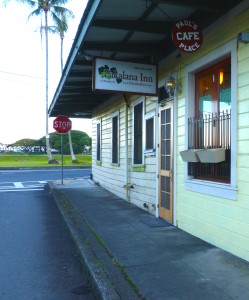Hilo Day One: June 29, 2015
Arriving in Honolulu after a ten-hour flight from Newark, we descended a mile to the south of Pearl Harbor. The Arizona Memorial’s white chopstick-rest profile was visible against the verdant margins of a turquoise cove. Debouching from the plane, our lungs filled with fresh air as we entered the terminal building, which was unencumbered by any measure of climate control and open to the free passage of breezes, birds and thankfully few insects. Cool sea breezes stirred the warm moist day as we trudged from our arrival gate to the opposite end of the terminal, where we boarded an inter-island flight to Hilo.
Passing over stretches of the Pacific we recognized the long form of Molokai, and the gourd-shaped contours of Maui before approaching the cliff-bound northern shores of the Big Island and the grassy Kohala highlands, before descending above the forests and farm-fields of the Hamakua Coast, crossing Hilo Bay and landing at the airport a few miles south of the town.
Greeting us was a diminutive Japanese woman holding a taxi-placard marked “Manthorne”. Draping orchid leis around our necks, she welcomed us to Hawai’i. We exchanged pleasantries and bowed to one another. I gave her a five-dollar bill.
Smiling, she hastened off to her next assignment. Kathie’s brother Jay had arranged for our welcome. A retired Coast Guard air/sea-rescue helicopter pilot, for several years he had been posted to Honolulu and grown fond of island customs.
Black clouds gathered above Mauna Kea and Mauna Loa, while seaward skies were clear and blue. The air was warmer and more humid than at Honolulu. Likewise the arrivals terminal in Hilo was open to the elements. We found the baggage claim located beneath what reminded me of a sprawling marquee—essentially a roof providing shelter from light rain but what seemed like little protection from the high winds that must accompany so many tropical storms that blow through the islands. As we dragged our bags off of the carousel, I saw Michael Marshall standing by the curb. He smiled in recognition, approached and festooned us with two more orchid leis. It seemed impossible that Mike and I had not laid eyes on one another for thirty-nine years. I handed him my iPad and asked him to take a few pictures of Kathie and me.
Following some minor confusion regarding the status of our rental car, Mike drove us to our quarters in downtown Hilo, where we deposited our luggage, and Kathie to unpack it. He gave me the quick motor tour of Hilo, which led us to an Enterprise car rental agency located on a highway strip at the edge of town. Papers were signed. We parted company and I drove the Pacific-blue Nissan back to the Pakalana Inn in the town center. Located on the second floor above a café, breakfast grill, ukulele shop, the inn was owner-run by a thin, vaguely hirsute, informal fellow named Neil. Four basic studio apartments can be had at the inn for the night or for the month, according to the requirements of Neil’s guests. The university used the Pakalana Inn as lodgings for new faculty members, visiting academics and the occasional reception. A groaning swamp cooler provided some comfort from the midday heat.
The room was equipped with a large wooden Roaring Twenties armoire, a large sofa, upholstered armchair, queen bed and contemporary café table, with chairs en suite. Neil cautioned us against leaving the bathroom door ajar. Unlike the windows in the main room, the bathroom was equipped with the leaky glass-louvered fenestration I recall in beach motels on my childhood holidays.
Ours was the corner room of a wood frame and corrugated steel building. The windows on one side of the building faced the loading dock of a guitar shop, and on the other the northern fringe of a memorial park that had been created when the City of Hilo decided not to rebuild a portion of the town that had been devastated by a tsunami in 1930.
As the guitar shop across the street closed for the day, I noticed a homeless Asian man unsling his backpack and make camp on the loading dock. He nodded to the storeowner, who nodded back, got in his car and drove away.
Famished, we discovered that on Monday nights Hilo restaurants that were open closed early. We dived into the nearest one we could find, descriptively named Reuben’s Mexican Food. A couple of watery Margaritas and decent meals later, we staggered back to the Pakalana and collapsed into bed.
The homeless man was there when we went to sleep, but in the morning a dirty woman and her dog asleep on the loading dock, had taken his place. Beside them, resting on its kickstand was a new, well-maintained bicycle.
I was reminded of the late Lester Johnson’s description of Bowery bums stirring from their slumbers like the dead stiffly returning to life, becoming limber, animated and alert until they found their way to a bottle of cheap wine, stupefaction and another sleep like death. And then the process would repeat itself. I wondered what stories unfold in Hilo during the wee hours of morning, of lost souls and night crawlers, which like vampires, vanish at daybreak.
